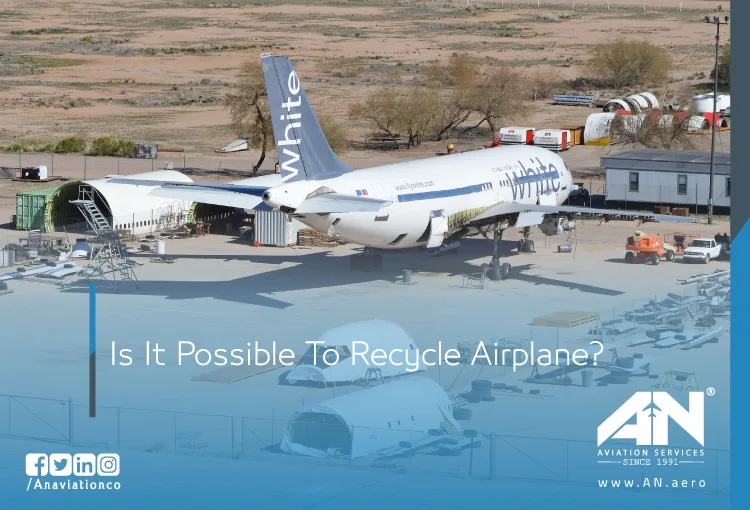
When an airplane completes its service life, the question arises: what happens to it? Does it become scrap metal or something more meaningful? Surprisingly, the answer lies in airplane recycling, an industry that has developed into an essential component of sustainable aviation. While recycling aircraft is no small task due to their complex construction and variety of raw materials, it is both possible and increasingly common. This process not only minimizes waste but also repurposes valuable components, giving airplanes a second life in ways you might not expect.
Let’s explore how aircraft are recycled, the challenges involved, and why this process is so important for the aviation industry‘s sustainability goals.
The Lifecycle of an Airplane: When Does Recycling Start?
Most airplanes are designed to last between 20 to 30 years, depending on maintenance, usage, and advancements in technology. Once an aircraft reaches the end of its operational life, the decision is made to either store it in an airplane “boneyard” or disassemble it for recycling.
Aircraft recycling begins with dismantling the plane. This complex procedure ensures reusable parts and materials, such as aluminum and composite materials, can be disassembled and recycled. The process helps recover valuable resources while minimizing environmental impact.
How Airplanes Are Recycled: A Step-by-Step Breakdown?
1. Initial Assessment:
When an aircraft retires, it undergoes an initial evaluation to determine the condition of its components. Key factors like the resale value of parts and the plane’s composition are considered before dismantling begins.
2. Dismantling and Component Recovery:
The first step in recycling involves removing reusable parts such as engines, landing gear, avionics, and other systems. These components are inspected, refurbished if necessary, and sold to operators or dismantlers and recyclers for use in other planes.
3. Material Separation:
Once the reusable parts are removed, the airplane is stripped down to its structural components. The remaining materials, including raw materials like aluminum, titanium, and steel, are separated for further processing. Composite materials—such as carbon fiber reinforced polymers—are more challenging to recycle but are increasingly being addressed by innovative recycling technologies.
4. Recycling and Repurposing:
Recovered materials are sent to recycling facilities, where they are melted down or processed into new forms. For example, aluminum from aircraft can be repurposed into construction materials or even used to manufacture new aircraft.
Challenges in Aircraft Recycling
While aircraft recycling has come a long way, it’s not without its challenges:
- Composite Materials: Many modern aircraft, such as the Boeing 787 and Airbus A350, are made from composite materials like carbon fiber. These materials are lightweight and durable but are far more difficult to recycle compared to traditional metals like aluminum.
- Complex Construction: Airplanes are made from hundreds of thousands of components, each requiring specialized handling during disassembly and recycling.
- Environmental Regulations: Aircraft recycling must adhere to strict environmental guidelines, ensuring that hazardous materials like fuel residues and lubricants are properly disposed of.
- Cost: Recycling an airplane is an expensive process that requires skilled labor and specialized facilities, which can limit the profitability of the endeavor.
The Importance of Airplane Recycling
1. Environmental Benefits:
Airplane recycling significantly reduces waste. By repurposing materials and parts, the industry minimizes the need for raw resource extraction, cutting down on energy use and greenhouse gas emissions. Recycling also helps prevent aircraft from being abandoned in “boneyards,” where they can become environmental hazards over time.
2. Economic Value:
Recycled aircraft parts and materials have immense economic value. For example, refurbished engines and avionics can be resold at a fraction of the cost of new parts, benefiting airlines and maintenance companies.
3. Industry Sustainability:
With the aviation sector under pressure to become more sustainable, airplane recycling aligns with broader goals to reduce the industry’s environmental footprint. Recycling also supports the circular economy by ensuring materials are reused rather than discarded.
Innovations in Aircraft Recycling
As the aviation industry evolves, so do recycling technologies. Some of the most promising advancements include:
- Composite Recycling Solutions: Researchers are developing methods to break down composite materials into reusable fibers and resins, making it possible to recycle modern airplanes more efficiently.
- Automated Dismantling: Robotics and automation are being introduced to speed up the dismantling process, reducing costs and improving precision.
- Alternative Uses for Recycled Aircraft: Some dismantled planes find creative new uses, such as being converted into unique housing, hotels, or even office spaces.
Conclusion: The Future of Aircraft Recycling
Recycled aircraft hold immense potential for reducing waste and contributing to a more sustainable aviation industry. While challenges remain, the growing demand for eco-friendly practices and advancements in recycling technologies are pushing the boundaries of what’s possible.
From raw material recovery to the creative repurposing of airplane parts, the process of airplane recycling is a testament to the industry’s commitment to sustainability. So, is it possible to recycle an airplane? Absolutely—and it’s becoming an essential part of aviation’s future.
By investing in innovative recycling methods and supporting sustainable practices, the aviation industry is taking flight toward a cleaner, greener tomorrow.

